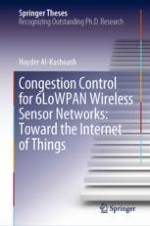2020 | OriginalPaper | Chapter
5. Game Theory Based Congestion Control Framework
Author : Hayder Al-Kashoash
Published in: Congestion Control for 6LoWPAN Wireless Sensor Networks: Toward the Internet of Things
Publisher: Springer International Publishing
Activate our intelligent search to find suitable subject content or patents.
Select sections of text to find matching patents with Artificial Intelligence. powered by
Select sections of text to find additional relevant content using AI-assisted search. powered by
